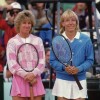By Randy Walker
@TennisPublisher
Look who’s 40!
It was 40 years ago on March 22, 1973 in Akron, Ohio of all places, where the greatest rivalry in the history of tennis – and some could argue of all sports – began.
On March 22, 1973, in front of a few hundred fans, 18-year-old Chris Evert of Florida defeated 16-year-old Martina Navratilova of communist Czechoslovakia, 7-6 (5-4), 6-3 at women’s professional event in Akron.
“Noticed by no one but the two players themselves was a first round match at Akron, a 7-6 (5-4) 6-3 win by Evert (the tournament victor) over a chubby Czech named Martina Navratilova,” wrote Bud Collins in his authoritative tennis encyclopedia THE BUD COLLINS HISTORY OF TENNIS. “That initial meeting was merely the first step in the lustrous rivalry that was to run for 80 encounters over 16 years.”
In the 80 matches of their rivalry, Navratilova had the head-to-head advantage by a 43-37 margin. Evert won the first five meetings before Navratilova won the only match between the two that was determined by a final-set tie-breaker – and their closest match – in the quarterfinals of the 1975 Virginia Slims of Washington, D.C on indoor carpet. That win for Navratilova by a 3-6, 6-4, 7-6 (5-4) margin was determined by a sudden-death point at 4-4 – a simultaneous match point for both players – in the final-set tie-breaker when tie-breakers were first-to-five-points “9-point” tiebreakers.
Evert’s most lopsided win over Navratilova was a double-bagel – a 6-0, 6-0 decision in the Amelia Island, Florida final in 1981. Navratilova’s most one-sided wins over Evert came in 6-2, 6-0 wins in the 1983 Virginia Slims Championships final in 1983 in New York and the 1984 Amelia Island final.
In all finals, Navratilova held a 36-25 advantage and in all matches at major tournaments, Navratilova lead 14-8. In major finals, Navratilova won 10 matches to Evert’s four. In non-major finals, the series was tied 19-19 and in three-set matches, Evert had the edge 16-14. Evert won 11 of the 14 matches played on clay, but Navratilova won the head-to-head on hard courts (9-7), grass courts (10-5) and on carpet (21-14).
In his new book THE GREATEST TENNIS MATCHES OF ALL TIME ($28.95, New Chapter Press, available here: http://www.newchaptermedia.com/the-greatest-tennis-matches-of-all-time/), tennis historian Steve Flink rates the 1981 Australian Open final – won by Navratilova 6-7 (4), 6-4, 7-5 – and the 1985 French Open final – won by Evert 6-3, 6-7 (4), 7-5 – as the two most significant of their confrontations. Flink describes this epic rivalry in this excerpt from his THE GREATEST TENNIS MATCHES OF ALL TIME book below.
“During the last quarter of the twentieth century, there were no series of matches more engaging than those played by Martina Navratilova and Chris Evert.
These clashes pitted a demonstrative, left-handed serve-and-volleyer against a patient, disciplined baseliner. They met in head-to-head competition eighty times between 1973 and 1988. The collided at least four times in every major championship. They battled gamely indoors and out, on slow and fast surfaces, in good and bad conditions, throughout their careers. Their rivalry was regarded by the vast majority of authorities as the greatest in the history of the game—not excluding the men. Others placed their confrontations in an even grander category as the most compelling rivalry produced in any sport. From the outset, the Evert-Navratilova matchup had everything working for it. As Evert herself said when she reflected on the rivalry for this book, “What made it interesting all along was the contrasts between Martina and me. If you have two players with the same kinds of games and personalities, it can be boring and repetitious. But we had so many things about us that were different. She came from Czechoslovakia and I was from Florida. She was left-handed and aggressive. I was right-handed, with a two-handed backhand, and a counterpuncher. I internalized things and she did not. We both brought our own set of fans into each match we played.”
The contrasts did not end there. Navratilova was sturdily built and over time became muscular and ruggedly athletic. Evert was known as “The Girl Next Door” and was a model of womanly grace and elegance. Navratilova was often outspoken and emotional; Evert was diplomatic and polite in the public arena. Evert turned her restraint and dignity into enduring attributes; Navratilova used her passion to engender popularity with her audiences. Navratilova would protest questionable line calls genuinely but sometimes caustically; Evert would simply register her disapproval with a stern glare at the officials. And yet, there were some subcutaneous similarities. Their respect for each other as professionals was visible and sincere. Both women were highly intelligent in person and as players.
They would become better at their craft because of the demands they placed on each other with such different brands of play. Finally, Chrissie Evert and Martina Navratilova stayed at or near the top of their profession for much longer than they could have imagined when they started their climb up the ladder.

